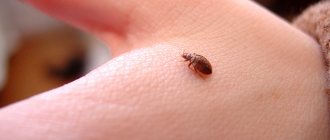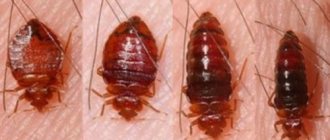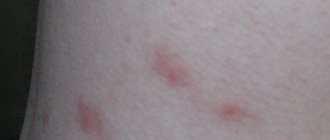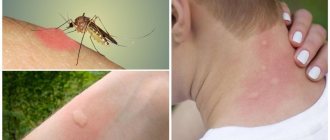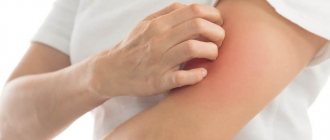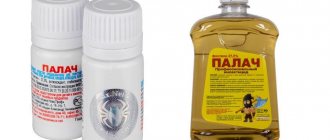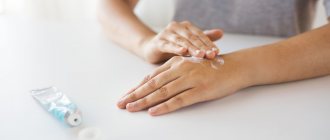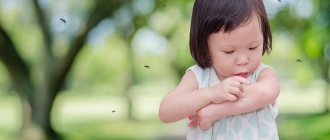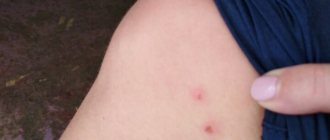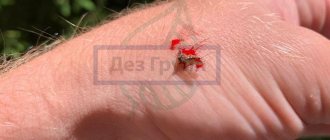How mosquitoes bite
In mosquitoes, only females fly out to hunt, since their need for food increases after fertilization - feeding is necessary for the full development of eggs.
During the night, a mosquito is able to attack up to 20 times, if it has unhindered access to the victim. The female strives to get fully drunk in one go, which is twice her weight - 5 ml. Mosquitoes attack places that are not covered by anything: legs, arms, shoulders, neck, back. Even the scalp will not become an obstacle for them. The peak of activity occurs at dusk, but can also bite during the day. The marks remain on the body in a chaotic manner.
The mosquito pierces the skin, then injects a substance with saliva that prevents blood clotting. This makes the saturation process easier. A person feels a harmful attack instantly, due to the appearance of acute pain and burning. Literally after a couple of seconds a blister and redness appear, followed by itching.
The body reacts differently to a mosquito bite, but in most cases the signs are as follows:
- swellings, up to 5 mm in diameter;
- presence of swelling during the first 2 hours;
- disappearance of itching after alcohol treatment of the affected area;
- unpleasant symptoms disappear within a day on their own;
- the epidermis is quickly restored.
In people with a predisposition to allergies, symptoms are more pronounced and severe. Sometimes even medical intervention is required.
There is no systematic pattern in mosquito attacks - they can bite at night and retreat through an open window during the day. Bedbugs are a nuisance every day.
Bedbug bite
Bed bugs function equally actively, regardless of the seasonal period. They settle close to humans - the main source of food. The optimal conditions for their life are temperature within 20-30 °C. They form nests mainly near a sleeping person - in sofas, beds, armchairs.
Bloodsuckers crawl out to hunt at night - from 3 to 7 am. They follow the scent of a sleeping victim, focusing on calm breathing. Since when they bite they release an anesthetic substance, the person does not immediately feel anything.
An adult female parasite feeds once every 7-9 days, larvae - daily. Due to this feature, bites on the body appear periodically. This makes it difficult to timely detect pests indoors. But with mass infection, bloodsuckers begin to feed more often. An adult spends about 20 minutes to satiate, nymphs get drunk in 2-3 minutes.
In one go, the mosquito needs to drink up to 7 ml of fresh blood. Since this does not succeed at first, the parasite crawls away and makes a second attempt. There can be up to 25 such injections, at a distance of 1-4 cm. Therefore, the trail looks like a chain. Since parasites go out hunting in groups, a person can get up to 500 bites per night.
The bug is equipped with a special proboscis with a sharp tip. When punctured, the anesthetic is released with saliva. While the victim does not feel anything, he sucks the blood. The result is a bulge with a red dot in the middle. For allergy sufferers, such attacks can cause serious consequences: urticaria, Quincke's edema and even anaphylactic shock
The resulting severe itching cannot be relieved by anything. Sometimes you have to resort to pharmaceuticals.
Bed bug bite
Bed bugs parasitize with the same activity regardless of the time of year, since they live in a person’s home. Comfortable temperature for normal life of bedbugs is 20-28 degrees Celsius. Parasites feed exclusively on human blood, so they form nests in the room where a person sleeps.
On a note!
Bed bugs are active at night, from approximately 3 o'clock to 8 am. The location of the victim is determined by the smell of carbon dioxide, which is released when exhaled. He begins to eat when a person falls asleep soundly and stops moving. Therefore, bites are discovered in the morning.
Nutritional Features
An adult female feeds once every 10 days. Larvae of different generations almost every other day. Bed bugs tend to bite periodically due to their feeding habits. However, if the premises are heavily infested, signs of an attack appear almost every day.
On a note!
During a bite, the bug injects a special substance that thins the blood, prevents it from clotting, and also numbs the pain for several minutes. For this reason, a sleeping person does not feel the attack of the parasite, and only discovers traces of bedbug bites in the morning.
Bedbug bite
Appearance
It is almost impossible to distinguish between a mosquito bite and a bedbug bite externally. Swelling, redness, a small dark spot in the center of dried blood. However, the itching is much stronger, and the location of the bites has a certain sequence.
The female drinks about 7 ml of blood during one meal; the meal lasts about 20 minutes. During this time, the insect bites several times, at a short distance. Characteristic traces remain in the form of a path, and the blisters themselves are placed in pairs. This is the main sign of how to recognize the presence of bed bugs in the house.
On a note!
Bedbugs select certain areas of the body where the vessels are located closer to the surface - neck, back, arms, legs. They almost never bite the stomach, head, or chest. They prefer the delicate skin of children and women; men are less likely to suffer from parasite attacks. Open areas of the body are attacked, but with a strong feeling of hunger, bedbugs can easily crawl under the blanket.
Another difference is that bedbug bites are much more painful, heal more slowly, and the itching lasts for several days. The final restoration of the skin, without the addition of a secondary infection and the development of severe allergies, occurs within a week.
How a bug bites
At first glance, the marks of bedbug bites are no different from mosquito bites. But if you got rid of the winged bloodsuckers and no one buzzes over your ear at night, but marks appear on the skin, these are bedbug bites. Bed parasites can be recognized by wounds on the skin.
- The bites are arranged in rows. The bug bites several times in a row and the marks form a path on the body. The lesions are located at a distance of approximately 3 cm from each other.
- The wounds form a circle of redness and a pronounced core - the “head” of the bite. The puncture site itself becomes brown in color.
- Another way to distinguish a mosquito bite from a bedbug bite is the location of the wound. A mosquito can only sting exposed areas of skin; the bug bites all over the body, trying to find places where blood vessels pass closer to the surface of the skin.
- Bedbug bites itch longer and do not go away on their own, as is the case with mosquito bites.
- Itching appears. After a bug attack, itching does not begin immediately, but 20-30 minutes after the bite. If you haven’t heard mosquitoes, but suddenly itching and redness appear, it’s time to wonder if you have bedbugs.
How mosquitoes bite
- It should be noted that only females go hunting, using blood to conceive a new generation of bloodsuckers. Insects are active at +16C, and prefer a humid climate. They are equipped with special sensors that detect warm-blooded animals at a distance of up to 3 kilometers.
- The female, having noticed a potential victim, flies around her with a characteristic annoying sound. A person practically does not feel a mosquito landing on him, but he perfectly feels the itching caused by the bite.
- The insect uses its lower jaw to make a thin incision in the skin, through which it inserts a needle-shaped proboscis. The device is protected by a special case, because it is quite fragile, and is designed for one-time use.
- Before starting a meal, the female releases a substance through her proboscis that impairs blood clotting. Thanks to it, the red liquid does not turn into a clot, but easily enters the mosquito’s abdomen.
- The site of the bite can be recognized by the characteristic swelling that forms around the microscopic incision. The skin turns red, itching appears, which lasts from a day to 2 - 3 days. Redness and swelling disappear approximately on the second day, leaving behind small itchy spots.
A person must know how to distinguish a mosquito bite from a bedbug bite in order to recognize the enemy in time and solve the problem.
How to find out which insect bit you: a bug or a mosquito
Features of bites:
- Externally, if it is summer time, then it is quite difficult to distinguish the bites of these bloodsuckers. Especially if there are a large number of flying insects in the house or you accidentally fell asleep in nature. In this case, a decent number of red, raised spots will appear on the body, which are characteristic of a mosquito bite. But if you notice such bites in the winter, you should think about it, because there is a very small chance that in winter it will be mosquitoes flying in your room, and not bedbugs.
- As for mosquito bites, these bloodsuckers usually bite in places not covered by clothing, that is, bare. Bedbugs are much more agile; they can bite places that are under clothing. Because they do not fly, but crawl, and can crawl anywhere, including under clothing, even if it fits quite tightly to the body. Accordingly, if you wake up in the morning and find red spots that are under thick clothing, most likely you were bitten by bedbugs, not mosquitoes.
- Another distinctive feature of bedbug infestation is the presence of severe itching. When they bite, they break through the skin. To ensure that the victim does not feel the bite and cannot throw off the parasite, they secrete a special anesthetic that causes a very severe allergy. Therefore, 20-30 minutes after the bite, severe itching begins. The area may become swollen.
- Very often, young children scratch such lesions, thereby introducing a secondary infection, staphylococcal or streptococcal. Thus, a combined infection is obtained, which contains traces of allergies, as well as bacterial damage. Please note that mosquitoes, especially females, can be quite aggressive, so they buzz a lot and can land several times on the place from which they are driven away.
- In addition, bedbugs never bite into the skin with their jaws just once. To get enough, they need about 7 ml of blood. To obtain this amount of liquid, it is necessary to pierce the skin several times in different places. This creates a kind of trail of bites and red spots. In addition, such spots, unlike mosquito bites, have a pronounced apex, because the bug has massive and pronounced jaws that pierce the skin quite strongly. This leaves a blood clot on top, called a red spot, which usually resembles a wound after the skin is damaged by baking the blood.
Patterns of bites of various insects
How do bed bugs bite?
A man was bitten by a bug
The child was bitten by bedbugs
Many people recommend this remedy for bedbugs. Read >>>!
All photos of bedbug bites can be viewed here
- Small inconspicuous insects that prefer to go hunting at night, while the potential victim sleeps peacefully. They live in mattresses, cracks in floors or walls, pillows and furniture.
- The bug is equipped with two proboscis, one of which pierces the skin, making its way to small vessels, and the second simultaneously injects an anesthetic liquid so that the “food” does not feel anything.
- The “predator” drinks 1.5 ml of blood from the puncture and moves a few centimeters forward to try another area.
- The bug makes about 5 - 6 bites per night, which resemble a kind of path.
- If mosquitoes bite through thin fabric, then “bed predators” prefer open areas of the body: face, legs, neck, arms. Sometimes they decide to travel in their pajamas, and then their back and stomach suffer, and more often their lower part.
- The bites resemble small red pimples, which are accompanied by unbearable itching and sometimes additional rashes. Bedbugs are characterized by “paths” of blisters, of which there may be several or many, depending on the number of insects.
What to apply to prevent bedbugs from biting
What are the differences between mosquito bites and bedbug bites?
At first glance, it will not be possible to distinguish who bit - a bug or a mosquito. The affected area turns red, is very itchy and begins to itch. For this reason, many may think that a mosquito did it.
Mosquitoes are easy to spot. Parasites become active at night, begin to fly, squeak annoyingly, land on the body, and bite. And if there are several of them, they will probably not let you sleep.
It is noteworthy that apartment bugs do not manifest themselves in any way; they quietly crawl around the apartment, find a victim and attack it. Their bite is quite unpleasant, it is somewhat reminiscent of a mosquito.
So, there are quite a lot of similarities, but there are still differences, the presence of which will help clarify the situation for those who really want to know how to distinguish a bug bite from a mosquito bite. Let's consider the characteristic features.
Appearance
It is impossible to distinguish between a mosquito bite and a bedbug bite.
It has common external features:
- red pimples appear on the affected areas;
- redness and swelling gradually appear;
- a small dark dot of dried blood is found on the blister;
- there is a feeling of severe itching.
However, with bedbug infestations, the itching sensation is much stronger. The location of the bites has a sequence in the form of paths.
A female bedbug drinks 7 ml of blood in one meal. Suction of this amount lasts 20 minutes. During this period, the insect attacks several times at a short distance. Tracks remain on the surface of the skin, and the blisters are placed in pairs.
Bedbug infestations are accompanied by severe pain and itching. They heal slowly, and the feeling of irritation may persist for several days.
The final restoration of the cover without the addition of infection and allergies occurs after a week.
Localization of bites
Bedbugs choose open areas of skin with close blood vessels. Bloodsuckers often attack the neck, back, arms, and legs. Mosquitoes attack everywhere, and their bites look like separately located red pimples or blisters.
They attack the entire body, starting from the heels and ending with the head. But bedbugs will not infect the abdomen, chest, or head.
Bedbugs prefer delicate skin, so they often attack women and children, but men suffer from them much less often.
They attack open areas of the integument, but in severe hunger they can crawl under the covers.
Reaction to bites
It is not always possible to distinguish between damage from bedbugs and mosquitoes, because they have similar symptoms.
The following unpleasant reactions can be detected on the surface of the skin:
- red spots appear;
- when combed, they increase in size;
- after a while, instead of spots, red blisters appear, in the center of which a dark dot of dried blood is found;
- the affected areas may swell greatly.
The difference between mosquito bites and bedbugs is that they can be located all over the body.
Parasites can bite through the skin in any area, and the lesion is always accompanied by pain and itching.
Consequences of bites for the body as a whole
Bedbug and mosquito bites are especially dangerous for children. Together with saliva, these parasites can introduce dangerous infections into the blood. They often cause severe allergies, which can pose a serious health hazard.
Insects can introduce dangerous bacteria and microbes into the blood, which can subsequently lead to the following dangerous diseases:
- parasites can spread HIV infection from another infected person;
- various viral diseases;
- plague;
- tularemia;
- fever;
- skin rashes;
- any other dangerous infections.
How to distinguish a bug bite from a mosquito bite
These insects are most common in human homes. Among mosquitoes, only females bite. In 8-10 hours, the pest makes 12-15 attacks, the total volume of blood obtained is about 6 ml.
All representatives of bedbugs are active:
- males;
- females;
- larvae.
An adult goes hunting every 7-10 days, young offspring - every day.
Young bugs go hunting every day.
Bedbugs mainly find victims by smell, reacting to the following substances:
- sweat;
- exhaled carbon dioxide.
Sensitivity allows you to determine a source located at a distance of up to 30-35 m.
The mosquito also uses its sense of smell and additionally infrared vision. It allows the pest to freely navigate in the dark and find a victim at a great distance.
Visually and in symptoms, the bites are similar, but there are significant differences.
Appearance
In both cases, the injured area of skin appears red and swollen (hyperemia). There are the following distinctive features:
| Sign | Mosquito | Bug |
| Swelling diameter | 5-6 mm | 7-10 mm |
| Character of the bite | Single tubercles. | Traces of 2 bites are nearby. Often several such pairs form a track. |
| Borders | Clearly delineated. | Blurred. |
| Apex of swelling | It has no distinctive features; the entire tubercle looks the same. | There is a spot of dried blood. |
Localization
Both types of parasites prefer exposed areas of the body. Thanks to its ability to fly, the mosquito is freer in its choice, so areas with thin skin are most susceptible to its bites:
- elbow and popliteal bends;
- neck;
- ears;
- head;
- fingers and toes.
Parasites prefer the elbow creases.
The insect does not get under clothes. Only sometimes it bites through it if it is made of particularly thin fabric.
The bug cannot fly and therefore is less selective - it bites wherever it needs to. It often penetrates under clothing, so traces are found not only in open areas.
How an insect bites
A mosquito has one proboscis and bites once. That is why single swellings occur. The duration of the attack is several seconds.
The bug has the following distinctive features:
- 2 proboscis. The second is used to inject the anesthetic. Therefore, the bites are paired.
- During one meal, it pierces the skin twice or three times, each time moving slightly. He does this to get more blood or find a more suitable place. As a result, traces of attacks form a trail.
The duration of an attack by bedbugs is (in minutes):
- adult – about 20;
- larva – from 5 to 7.
Body reaction
The body responds to a parasite attack in different ways:
| Reaction | Mosquito | Bug |
| Sensations during a bite | A slight prick, a sleeping person does not notice. | Unpleasant sensations are more pronounced and often cause awakening. The bites of the larvae are especially painful, because... they do not inject anesthetic. |
| Itching | Appears immediately and can be removed relatively easily with a disinfectant or soothing ointment. | It is felt after a few hours or the next day, which is explained by the injection of an anesthetic secretion. Strongly expressed, removed with great difficulty. |
| Duration | Swelling persists for several hours; in the absence of complications, the bite marks disappear within a day. | The bite lasts up to 10 days. |
Other differences
There are a number of other features:
| Mosquitoes | Bedbugs |
| When flying they make a characteristic squeak. | They attack silently. |
| They hunt around the clock, attacking those who are awake. | They crawl out only at night, after about 3:00. They attack only sleeping people. |
| In winter they hibernate. | Active throughout the year, they bite most in summer. |
| They don't leave marks on the bed. | Drops of blood are found on the sheets, either leaking from a wound or resulting from crushing an insect by a sleeping victim. |
| Bites appear daily. | Blisters appear every few days. Only over time, when the insects multiply greatly, do the bites become daily. |
| In most cases, traces of attacks are found on all family members. | At first, one of the people living in the apartment is bitten. This is due to the fact that bedbugs do not immediately spread throughout the home. |
Why are bedbug bites dangerous?
Many people think that, as in the case of mosquitoes, there are no consequences from bedbug bites other than redness and itching. Actually this is not true. Small parasites can become carriers of infectious diseases.
The itching causes an unbearable desire to scratch the bite site; this is strictly forbidden. It is easy to get an infection into the wound, and complications are not far away.
Multiple stings cause swelling, which can be quite painful.
For children, who suffer more from parasite bites, bedbugs are dangerous as allergy triggers. The allergic reaction also occurs in adults. A bug bite causes an allergic attack due to substances contained in the insect's saliva.
You shouldn’t discount the fact that bedbug attacks at night can deprive you of sleep. Irritation and depressed psychological state have a bad effect on performance.
If it is difficult for you to independently identify a bedbug bite, seeing many marks on the skin from an insect attack, consult a doctor.
What is the difference between a bug bite and a midge bite?
A small black insect annoys people outdoors during the warm season. Almost never appears indoors. But, if we take into account the fact that a person may not notice bites immediately after waking up, but before that there was an outing into nature, we can assume.
The peculiarity of a midge bite is a dark blood spot in the center. The insect doesn't just pierce the skin, it chews it out. The process is accompanied by severe pain. The person reacts almost immediately. There is a circle of redness and slight swelling around the bloody spot. The midge bite is very itchy. Much worse than a mosquito or flea. Pimples are arranged in any form, there is no chain. The midge bites exposed skin. Arms, legs, necks, and children’s faces suffer. The bite does not go away for a long time. You may experience discomfort in the affected area for about a week. Midges annoyingly attack in groups, but bite individually. Therefore, a large number of acne can be immediately detected by a person who has slept very soundly, and in nature. Bed bugs prefer a home environment.
Differences between mosquito and bedbug bites
There are several features to pay attention to:
| Mosquitoes | Bedbugs |
| They are active in the warm season. | They are active regardless of the season. |
| They can bite at night and during the day. | They bite only at night. This is one of the main signs by which parasites can be distinguished. |
| The bites are located randomly in different places. | Traces of bloodsucker attacks remain in pairs, forming a path. In some places they merge into one large spot. |
| The itching disappears after treatment with an antiseptic. | Doesn't go away within a few days. |
| A red blister with blurred contours. | A spot with a dark dot in the center is traces of dried blood. |
| Mosquito bites appear periodically; the presence of a mosquito is indicated by a thin squeak. | Unlike mosquitoes, bedbugs feed once every 7-10 days, there is a periodicity. When a room is heavily infested, marks appear on the body almost every night. |
| A sharp pain appears immediately. | A bug bite is characterized by severe itching; a person does not feel pain, thanks to a special secretion with analgesic properties. |
| Capable of biting through thin fabric. | They bite only on exposed areas of the body. |
| Spots appear on any area, even the face. | They prefer the back, hips, arms, shoulders, neck. Only children are bitten on the face. |
| They attack a potential victim at any time, anywhere. | They bite only in the bedroom, when the person is motionless—sleeping. |
A mosquito bite and a bedbug bite can be recognized not so much by their appearance as by their location.
How to distinguish a bug bite from acne
Some people have doubts about bites. They just think it's acne. As a rule, acne of a certain type appears on the body - subcutaneous, open. Open pimples look like red swellings, with a sign of an abscess in the center. Painful touches. The middle can be squeezed out. Subcutaneous pimples reveal themselves as severe swelling, pain, without an affected area in the center. In addition, acne appears in certain areas of the body. Where are the most sebaceous glands located? After all, one of the main causes of acne is clogged pores. Therefore, they can be found on the face, back, neck, and chest. In addition to this, bedbugs bite your legs and arms. Pimples appear randomly. It is impossible to trace the chain. Assuming that this is acne due to diseases. Other characteristic symptoms of the disease must be present.
In general, it is impossible to confuse a bug bite with ordinary acne.
What are the dangers of bloodsucker attacks?
Annoying itching and painful swelling at the site of the lesion are not the most pleasant sensations, but bites of blood-sucking insects also have much more dangerous consequences.
Mosquitoes are carriers of dangerous diseases such as:
- dirofilariasis;
- malaria;
- types of tropical fevers;
- meningitis;
- tularemia.
Serious infections enter the human body as a result of bedbug attacks:
- typhoid fever;
- smallpox;
- brucellosis;
- anthrax;
- Hepatitis B.
If a person is attacked by several bedbugs at once, it is even possible to develop anaphylactic shock. Children who are constantly bitten by bloodsuckers develop anemia, irritability and depression due to lack of proper sleep.
However, it is worth recognizing that HIV and other deadly diseases transmitted through blood are not transmitted by mosquitoes or bedbugs. The proboscis of insects only works to pump out blood, so that the blood of a sick person does not enter the body of a healthy person through pest bites.
Bloodsucker bites cause allergic reactions, which manifest themselves as:
- redness of the epidermis;
- allergic dermatitis and rashes;
- increased body temperature, fever;
- headache;
- difficulty breathing;
- swelling of the mucous membranes.
Secondary infection of scratched wounds is also dangerous, which in extreme cases leads to blood poisoning.
Mosquito and bedbug bites are similar only at first glance. Knowing the behavioral characteristics of insects and the body’s reaction to an attack by one or another pest, it is easy to determine who is the culprit of the unpleasant sensations.
Both situations have one thing in common: it is recommended to treat the bite sites with a disinfectant and not scratch them, so as not to introduce bacteria and infections.
Causes of a mosquito-like rash
When pimples appear, mosquito bites make you itch, which is not always possible to understand. To do this, you need to compare the rash with the usual mosquito and identify inconsistencies.
The problem may lie in:
- Damage to tissues by various blood-sucking insects.
- Allergic reaction to food.
- Prickly heat.
- Infectious pathologies.
- Allergic urticaria.
- Vascular diseases.
- Development of meningococcal sepsis.
Nutritional atopy
Sometimes food allergies resemble mosquito bites. It can occur with any product and in severe situations can even lead to anaphylactic shock.
A distinctive feature of atopy is that pimples appear even under thick clothing and can merge. A food allergy on the skin like the mosquito bites in the photo can subsequently change color, shape, and size. Atopy appears suddenly after ingesting an allergen. If you take an antihistamine, the symptoms decrease. Patients also complain of nausea, vomiting, abdominal pain, and sometimes an increase in temperature.
Prickly heat
Spots on the body similar to mosquito bites may appear due to non-compliance with the thermal regime. Miliaria is more common in infants and is observed in the form of a small rash on the neck, forehead, back, and chest. In severe cases, blisters and purulent rashes form. In this case, the pimples look like mosquito bites.
A distinctive feature is the increase in temperature.
Infectious pathologies
When acne appears, like the skin itches after a mosquito bite, the reason may lie in a number of infectious pathologies:
- Measles. When the virus enters the body, catarrhal manifestations and rashes are observed throughout the body. Subsequently, the spots turn brown. During the incubation period, the temperature may rise significantly.
- Chickenpox. Most often diagnosed in childhood. The rash appears gradually and resembles blisters. There is a clear liquid inside the pimple; if it bursts, it will leave a scar for life. Usually the pathology is mild, but may be accompanied by fever, weakness, and conjunctivitis.
- Rubella. Red rashes have a bump in the middle. The disease progresses with catarrhal symptoms: rhinitis, conjunctivitis, redness of the throat.
- Scarlet fever. The disease occurs with fever, sore throat, and red rashes.
- Molluscum contagiosum. The rash looks like small bumps with a white center inside. They can stay on the skin for a long time without causing any discomfort and are able to go away on their own.
- Roseola. It is characterized by an increase in temperature and the appearance of a pink, raised rash. Papules usually do not bother you and go away on their own in 3-4 days.
Allergic urticaria
It occurs against the background of an allergic reaction to household chemicals, dust, pet hair, and clothing. The rash resembles pink blisters, similar to burns. The patient feels weakness, itching, burning.
Diseases of the blood and blood vessels
Pimples appear in the problem area as if caused by a mosquito bite. In addition, small bluish areas resembling bruises form nearby. Typically, a rash appears when tissue is injured.
Meningococcal sepsis
The patient is concerned about hyperemia and rashes. Symptoms increase rapidly, so immediate medical attention is required. Usually papules are localized on the legs. Over time, they transform into purple subcutaneous spots.
Signs of a mosquito bite
The reaction to a mosquito bite can vary significantly. This depends on the individual characteristics of the patient, age, capillary stability, and the strength of the immune system.
In a healthy person, a small wound with swelling and redness appears at the site of penetration of the bloodsucker. The skin around it itches and hurts. If you do not scratch this area, relief occurs within a few days. When a child scratches the bite, the spot becomes larger and resembles a blister. Blood may be released from the wound, increasing the risk of infection.
Local signs
- Red areas on the body itch. Additionally, swelling and redness occur.
- Red spots on the body swell, and swelling also forms. The diameter of the swelling reaches 10-12 mm. Such symptoms do not last long in a child if he does not scratch them.
- When scratching the bite site, the baby develops wounds or blisters that are filled with a peculiar substance.
- With a serious allergic reaction to a mosquito bite, papules appear that gradually become denser. Most often, such consequences occur if the child is severely bitten by mosquitoes.
General signs
- Since the saliva of a blood-sucking insect penetrates not only under the skin, but also into the blood, severe swelling and swelling occurs. The swelling spreads to other areas. There are photos of mosquito bites online.
- If some areas become inflamed, the body temperature of an adult rises. It depends on how much the mosquito bites itch.
- Itchy spots appear on the head, arms and other parts of the body, which differ in diameter. If the bite site is swollen, then appropriate treatment is required. There are many medications for itching.
- There is also a more severe form of allergic reaction to mosquito bites in young children. In this case, nausea, headaches, and constant weakness occur. Such signs do not go away quickly.
Symptoms of Quincke's edema
- Nausea.
- Swelling or bump from a blood-sucking mosquito bite.
- Severe pain in the abdominal area.
- The bites itch and pimples appear.
- Rash or hives.
- Lumps or large bumps that spread throughout the body.
- Swelling and periodic spasms of the mucous membrane from a mosquito bite in a child.
Allergy symptoms
Urticaria, or urticaria, is characteristic of an immediate allergic reaction, and therefore occurs within a few minutes after contact with the allergen.
Photo: characteristic appearance of allergic urticaria
The symptomatic manifestations of urticaria are similar to those caused by a nettle sting or an insect bite. It is due to the identity of the type of rash that allergies are similar to mosquito bites. Below are the main symptoms indicating an allergy.
- With this condition, blisters appear on the skin throughout the body - small, dense, swollen, raised elements of a round or irregular shape that can merge with each other. Please note that the rash in this case also occurs in areas covered by clothing
- The blisters are pale pink in color, and the surrounding skin is normal or reddened. The rash is accompanied by severe itching.
- Unlike a bite mark, which can remain unchanged for a long time, the rash disappears without a trace after the cessation of exposure to the allergen.
- The allergic reaction disappears quite quickly or becomes symptomatic when taking antihistamines
- People around you do not have any symptoms of the rash.
Actually, allergic reactions also occur to mosquito bites and other insects (especially in children) and there are few of them that can be confused with.
Familiarize yourself with the characteristics and treatment of this allergy, as well as photographs of allergic reactions to mosquitoes and other midges.
How to identify a mosquito bite
It’s good if you saw that the child was bitten by a mosquito. In this case, you can immediately resort to recommendations for treating the wound and other measures that relate specifically to this insect. However, what if a reaction is visible on the skin, but you haven’t noticed the culprit of this trouble? First of all, you should make sure that your child suffered from the sting of the little bloodsucker. Let's look at the most common bites and possible reactions to them:
- a mosquito bite is usually single, accompanied by itching at the site of penetration of the sting, redness of small diameter, and often slight swelling;
- Bed bug bites appear as red itchy spots, sometimes blisters. Arranged in a row, in small groups of 2-3 bites side by side. The skin reaction may not appear immediately, but within a day after the bites;
- flea bites can be identified by small itchy red dots collected in groups;
- lice do not leave noticeable bites. They parasitize hairy areas, laying eggs. The presence of these insects is indicated by severe itching;
- Ticks often go undetected for a long time because their bite is painless. If the parasite has managed to drink blood and fall off the skin, the bite can be identified by a small single redness with a dark dot in the center;
- ants bite painfully, leaving many small dots on the skin;
- Bee and wasp stings are accompanied by sharp, severe pain and swelling. After a bee sting, an insect sting remains in the wound, which must be removed as quickly as possible;
- bites from non-venomous spiders are often painless or accompanied by minor pain. The bite site turns red, but does not cause any particular discomfort. Bites from poisonous individuals of this species are usually accompanied by pain, the development of inflammation at the site of the bite and general malaise (headache, fever, dizziness, convulsions, nausea, weakness, vomiting and others).
Photo gallery: mosquito bites and other insects on human skin
Without scratching and allergies, the site of a mosquito bite is a small red spot with compaction in the src=»https://zoolog.guru/wp-content/uploads/2019/06/post_5a5cd9683dd10-332×179.jpg» class=»aligncenter» width=”332″ height=”179″[/img] Tick bites can be detected by the presence of the insect itself on the skin or by a small red spot with a dark dot in src=”https://zoolog.guru/wp-content/uploads/ 2019/06/post_5a5cd96796c17-332×179.jpg" class="aligncenter" width="332″ height="179″[/img] Lice bites are invisible, but are accompanied by severe itching on the scalp
After ant bites, many small red dots remain on the skin
The bite of a common spider results in localized redness, which does not cause much discomfort and disappears within 1–2 days
Bed bug bites cause red itchy spots and blisters
Wasp and bee stings are painful and often cause swelling of the skin.
Fleas leave bite marks on the skin in the form of small red spots, with dotted dark spots in the middle
Attention! If a child or adult is bitten by a spider, or if you find bites that you cannot identify, you should immediately seek qualified help from the nearest medical facility. Self-medication and a frivolous attitude to such cases can cost your life!
Mosquito bite
A normal skin reaction to a mosquito bite is a single wound on an area of the body, accompanied by a slight rounded redness. Sometimes you can see a small hole in the center - a mark from the sting of a bloodsucker. Often in the middle of the redness a blister appears, reminiscent of a nettle sting. Itching is observed only at the site of the bite. If you do not comb the wound, all these manifestations disappear on their own within one or two days.
In the absence of allergies, the site of a mosquito bite is nothing to worry about
Culicidosis
A pathological (allergic) reaction to mosquito bites in children and adults is called culicidosis. The protein contained in the bloodsucker's saliva leads to sensitization of the body - increased sensitivity to the effects of irritants. The condition is characterized by various manifestations: from skin rashes to swelling of the upper respiratory tract. A papular rash appears at the sites of bites, which is accompanied by severe itching and pain. Elements of the rash may merge, covering large areas of the skin. The temperature may rise, rhinitis, sneezing, and lacrimation may appear. If immediately after the bite a suffocating cough or a feeling of lack of air appears, this indicates a more serious reaction of the body to the bite - anaphylactic shock and Quincke's edema. If you experience any allergy to a mosquito bite, you should consult a doctor as soon as possible!
Culicidosis is an allergy to a mosquito bite in humans.
Baby skin reaction
The manifestations of reactions to insect bites on the delicate skin of a child are more significant than in adults. As a result of a mosquito bite, most children suffer from very severe itching, causing an unbearable desire to scratch the wound. A large lump appears at the site of skin contact with the insect sting, and inflammation develops. The baby's general well-being may also deteriorate. If an allergic reaction develops and the symptoms described above appear, the child must be urgently taken to a medical facility!
Children's skin reacts more strongly to mosquito bites than adults' skin
First aid for allergic urticaria
The first step is to stop exposure to the allergen if possible. Next, if prescribed by a doctor, you must take an antihistamine (loratadine, fexofenadine, cetirizine). To reduce itching, you can use sunburn cream, and also change to cotton clothes.
Please note: On our portal you can read a detailed article about the symptoms, types and treatment of urticaria
If Quincke's edema develops, low blood pressure, nausea, vomiting, or loss of consciousness, you should immediately call an ambulance.
Treatment of allergic urticaria
Photo: Rash in the form of insect bites on a man's hand
The action of the allergen that caused the reaction ceases. In addition, the patient should switch to an elimination diet that excludes foods with a large number of allergens (chicken, citrus fruits, nuts, eggs, strawberries, spices, foods with a high content of dyes).
In acute cases of urticaria, antihistamines are prescribed.
In the case of the development of a severe form of the disease, infusion antihistamines, corticosteroids (prednisolone, dexamethasone), calcium preparations that reduce sensitivity to allergens (calcium chloride or gluconate) are used; when the allergen is taken orally, gastric lavage is performed, and activated carbon and other sorbents are also used.
For urticaria, the use of codeine, aspirin, including its derivatives, and ACE inhibitors is prohibited.
